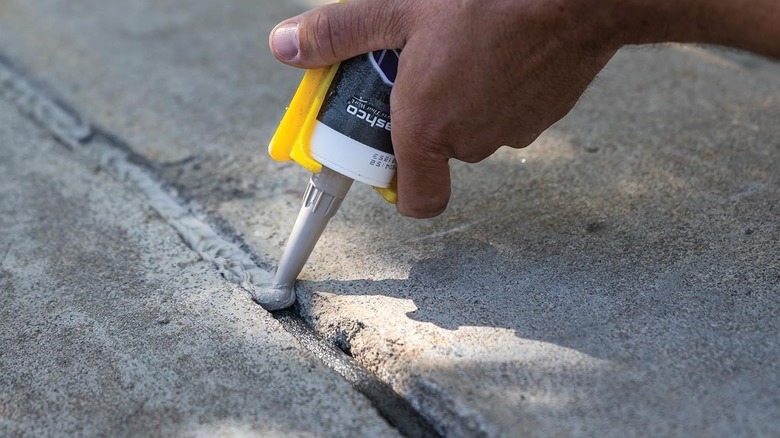The Affordable Tool That Can Fill Cracks In Your Concrete Driveway
We may receive a commission on purchases made from links.
The durability of concrete has made it a popular material for driveways. Although concrete driveways are made to withstand heavy traffic, the material is prone to cracking for various reasons — from severe weather events to overuse, one-off impacts, and regular wear and tear. Cracks can develop suddenly or gradually over time. No matter the cause, concrete caulk is an affordable tool you can use to repair concrete cracks in your driveway yourself.
Driveway cracks can be caused by external factors like driving heavy vehicles on the concrete, the ground shifting beneath the driveway, and tree roots growing under the concrete. A concrete driveway is also vulnerable to damage from sharp, heavy objects, such as shovels or powered yard tools. Water (from rain or melting snow) and salt can infiltrate small chips or cracks, expanding them over time.
A small crack can spread quickly, while a large crack can cause parts of your driveway to sag. So it is important to deal with them right away. The cost to repair your cracked concrete driveway professionally ranges from $0.50 to $3 per linear foot, depending on the crack size and number. Doing it yourself is much cheaper — a tube of Sikaflex Concrete Fix costs less than $10.
How to fill cracks in a driveway using concrete caulk
To fix driveway cracks, look for concrete caulk made from polyurethane over other materials. It will last for decades if you apply it correctly. Avoid indoor caulks, which are not designed to compensate for the expanding and contracting of concrete in cold or hot weather. There are two main types of concrete caulk: non-sag and self-leveling. If your crack is relatively uniform, self-leveling caulk will flow into it evenly with no extra work; non-sag caulk is best for small, uneven cracks.
Before applying concrete caulk to your driveway, start by cleaning any debris from the crack using a screwdriver, then a wire brush, and then a stiff-bristled broom or leaf blower. Smooth uneven edges using a grinder fitted with a diamond saw blade. If the crack is more than ½ inch wide, fill it with stone dust, sand, or heat-resistant backer rod, leaving ½ inch of space for the caulk. Apply the caulk to totally fill the crack, keeping it level with the driveway's surface. If you hate the look of the filled crack, wait 10 to 15 minutes and sprinkle on some dry sand to disguise it.
Let the caulk cure before using the driveway — about two hours for light traffic and up to five days for vehicles. Different concrete caulking products have specific curing times, so always check the manufacturer's instructions. If the outdoor temperature hits 80 degrees Fahrenheit, put off the task for a cooler day or you risk it not curing properly. Want to avoid cracks in the future? The essential task that can help prevent a driveway from cracking is regular pressure washing.

